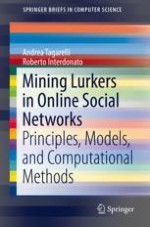2018 | OriginalPaper | Chapter
8. Bringing Lurking in Game Theory
Authors : Andrea Tagarelli, Roberto Interdonato
Published in: Mining Lurkers in Online Social Networks
Publisher: Springer International Publishing
Activate our intelligent search to find suitable subject content or patents.
Select sections of text to find matching patents with Artificial Intelligence. powered by
Select sections of text to find additional relevant content using AI-assisted search. powered by
